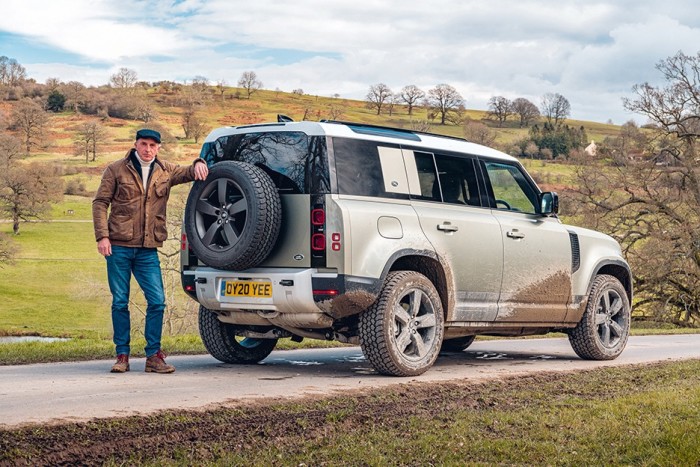The beloved Landy is back. But is it any good?

Roula Khalaf, Editor of the FT, selects her favourite stories in this weekly newsletter.
When Land Rover design chief Gerry McGovern was tasked with drawing up an all-new version of the carmaker’s signature model, he was faced with reinventing a bit more than the wheel. Since its launch in 1948, the Land Rover (which evolved into the car known as the Defender) had become a national treasure recognised the world over. Born out of the necessity to produce an all-round farm vehicle that could help get Britain back on its feet after the war, the original Land Rover had aluminium bodywork on account of a shortage of steel, flat panels, a bolt-on roof and a hose-out interior into which turnips, dung, tools and sheep could be thrown with equal alacrity.
Although the car remained famously tough, it was also famously prone to chassis and bulkhead rust, bereft of safety features, uncomfortable, draughty, as aerodynamic as a hay bale and as watertight as the Exxon Valdez, with which it shared a similar turning circle and a comparable ability to leak oil. Yet, despite its failings, the “Landy” became so beloved that when the company announced it was going to retire the old Defender (the last one rolled off the production line in 2016), there was an outcry. Nothing, said its fans, could ever replace it. McGovern, who sports bespoke Savile Row suits and handmade shoes rather than the T-shirts proclaiming “99 Problems and a Winch Ain’t One” that are favoured by hardcore Land Rover lovers, was regarded with extreme scepticism.
Notwithstanding the fact that I don’t even understand the slogan on the T-shirts, I am a big fan of the old-school Landy. I have both a 55-year-old example and a relatively modern 36-year-old that take us around the lanes of Devon in true golden-age style – that is, slowly enough to irritate drivers following in modern cars and uncomfortably enough to provoke impertinent eye-rolling when news breaks that one is going to be used for that day’s school run.

Now that I’ve proclaimed my allegiance to the “real” Landy, I can say that I have driven the all-new Defender – a near decade in the making. And it’s absolutely brilliant.
The new arrival has suitably purposeful looks and, as well as the long-wheelbase 110 model seen here, it will also be available as a short-wheelbase 90. In both cases the Defender has been engineered for strength from the ground up. The roof is capable of carrying a load of up to 168kg on the move (300 standing still), it will tow up to 3,500kg and, I was told, during extensive development testing it made light work of some of the toughest trails in Moab, Utah, including the infamous Hell’s Revenge, Poison Spider and Steel Bender routes.
I headed west on the less wild A44 towards Eastnor Castle in Herefordshire, site of the 5,000-acre off-road proving ground that has been used by Land Rover since the early 1960s. The first thing that becomes apparent is that the new Defender is leak-free, draught-free, cossettingly comfortable and furnished with fittings that owners of the old model could never even have dreamed of. The doors, for example, can be unlocked from a wrist-worn “activity key”, there’s a 10-inch infotainment touchscreen with Pivi Pro software that constantly updates over the air, a ClearSight Rear View mirror that displays a video image of what’s behind (good when towing or fully loaded) and a jet fighter-style head-up display that automatically adjusts to on- or off-road driving.
There’s also a Software-Over-The-Air system that remotely updates 14 of the car’s control modules, enabling it to self-upgrade its systems and fix any glitches, while a phone app makes it possible to keep track of fuel levels, journey history and location – it can even heat or cool the interior in advance of the driver’s arrival (quite a contrast to my old Land Rovers, which are freshened up manually by opening a couple of metal flaps beneath the windscreen).
By now, die-hards clinging to the belief that the previous Defender couldn’t be bettered will be citing the new one’s mod cons as irrefutable evidence that it’s a soft-roader good only for urban posing. They’re wrong… because everything about the new car has been thought out with hard use in mind.
The modular interior – which can be arranged in five-seater, six-seater or five-plus-two configurations – can be had in multiple trim options, with the car I drove featuring extra-resilient, washable textiles and rubberised, brush-out flooring. The rear seats fold completely flat to offer up to 2,380 litres of carrying capacity.

On a normal road, the car will prove a revelation to anyone who has owned an old Defender – it can be driven at motorway speeds without having to fight the steering wheel, wear ear plugs, or execute braking manoeuvres a fortnight in advance. More importantly, it excels off-road. Hardcore outback adventurers will rail at the ingenious electronics of the Land Rover Terrain Response System 2 on the basis that, should it go wrong in the middle of nowhere, you could be left up the creek (or in any other area of outstanding natural beauty) without the proverbial paddle. But since the Defender is said to have undergone 1.2 million km of testing between the minus-40-degree cold of the Arctic and 50-degree desert heat, a sudden failure seems unlikely.
The Terrain Response system adapts automatically to mud, ruts, sand, snow and rock crawling. It can also be set manually, even (uniquely) allowing for more or less wheelspin to be dialled in. Add to this variable hill descent control, an ability to wade through more than three feet of water and approach and departure angles of 38 degrees and 40 degrees respectively, and it soon becomes apparent that this is an extremely serious off-roader.
In fact, it felt more or less unstoppable on the muddy, root-strewn and sometimes flooded dips and climbs of the Eastnor proving ground, tackling terrain that only the most skilled of drivers (ie, not me) could contemplate traversing in an old-style Landy. And, for those hell-bent on adventure, Land Rover has already produced a range of Defender accessories and personalisation packs that include rooftop tents, expedition roof racks, lockable exterior stowage pods and roof ladders.
Aesthetic options, meanwhile, include a choice of steel or alloy wheels, multiple Defender-specific paint colours and the possibility of having the car “satin-wrapped” in protective film. Wrapping up a Land Rover? There are no prizes for guessing what the die-hards will have to say to that…
Comments